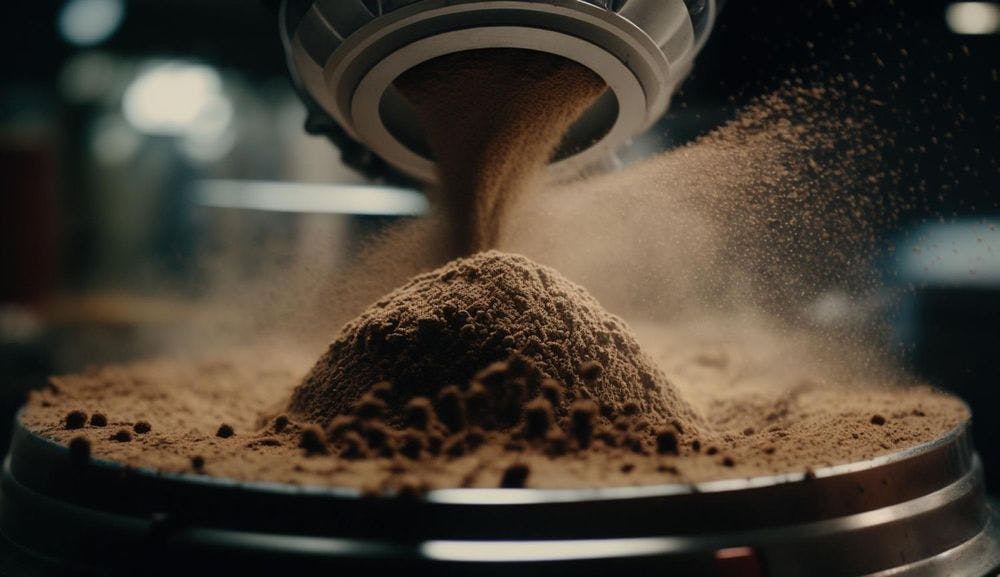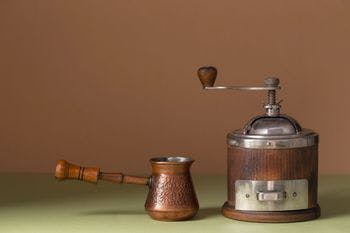
Conical vs Flat burr: Which coffee grinder is better?

The wrong coffee grinder can lead to you never being able to achieve a consistent and accurate flavor profile, regardless of the quality of your coffee beans.
We are all aware of the importance of a high-quality burr coffee grinder. However, we recognize there is more to the decision than selecting a reputable brand. Before making a purchase, one of the most important factors to consider is whether a conical or flat burr grinder is better.
This blog examines the features, benefits, and drawbacks, thereby comparing a conical burr grinder with a burr coffee grinder to assist you in deciding which is best for you.
Conical burr coffee grinder: Overview
What is a conical burr grinder?
A conical burr grinder is a kind of coffee grinder that uses a set of cone-shaped burrs to crush coffee beans into consistent and uniform grounds.
These burrs are generally made of stainless steel, ceramic, or sometimes even titanium, and they work by trapping coffee beans between the conical surfaces and crushing them as they rotate against each other.
This crushing action creates coffee grounds of various sizes, with the largest near the top of the burr set and the finest near the bottom.
Pros
1) Consistency
Conical burr grinders are known for their ability to produce consistent coffee grounds. The conical shape of the burrs and the slow grinding motion result in a uniform grind size, which is crucial for brewing a balanced and flavorful cup of coffee.
2) Reduced Heat
Conical burr grinders generate less heat during the grinding process compared to flat burr grinders. Excess heat can potentially alter the flavor of your coffee, so this is a significant advantage for conical burr grinders.
3) Quieter Operation
Many users appreciate the quieter operation of conical burr grinders. The crushing action of the conical burrs is often less noisy than the flat burr's cutting action, making it a more pleasant experience for early risers and those with sensitive ears.
4) Longer Burrs Lifespan
Conical burrs tend to have a longer lifespan compared to flat burrs. They are less prone to chipping or wearing out quickly, making conical burr grinders a more durable choice.
Cons
1) Slower Grinding Speed
Conical burr grinders are generally slower than their flat burr counterparts. If you're in a rush and need your coffee grounds quickly, there might be better choices for you.
2) Limited Adjustment
Some conical burr grinders have limited grind size adjustment settings. This may be better for coffee enthusiasts who prefer experimenting with different grind sizes for various brewing methods.
3) Coffee Retention
Conical burr grinders tend to retain more coffee grounds within the grinding chamber and in the chute compared to some other grinder types.
Flat burr coffee grinder: Overview
What is a flat burr grinder?
A flat burr grinder is a type of coffee grinder designed to efficiently and consistently grind coffee beans to a uniform size. It operates using two flat, disc-shaped burrs that are set parallel to each other.
These burrs have sharp cutting edges, and as coffee beans are fed into the grinder, they are sliced or crushed between the flat surfaces, resulting in grounds of precise and consistent size. One of the standout features of flat burr grinders is their ability to offer meticulous control over the grind size.
Pros
1) Precise Grind Size Control
Flat burr grinders are often favored for their precise control over grind size. This is crucial for espresso lovers and those who use various brewing methods, as it allows for fine-tuning the grind size to match your preference perfectly.
2) Faster Grinding
Flat burr grinders are generally quicker than conical burr grinders. This speed can be a significant advantage when you need your coffee ground quickly, especially in high-demand situations.
3) Wider Grind Range
Flat burr grinders usually have a broader range of grind sizes, from very fine to very coarse. This versatility makes them suitable for a wide range of brewing methods.
Cons
1) Increased Heat Generation
The flat, parallel burrs of this type of grinder can generate more heat during the grinding process, potentially affecting the flavor of your coffee, especially with prolonged use.
2) Louder Operation
The cutting action of flat burrs can be noisier compared to the crushing action of conical burrs. If noise is a concern, consider this when choosing a grinder.
3) Retention of Coffee Grounds
Flat burr grinders can have issues with retaining coffee grounds in the grinding chamber or chute, leading to a potential mixture of stale coffee grounds from previous grinds with freshly ground coffee. This can impact the freshness of the brew.
Conical vs Flat burr grinder: Quick comparison
1) Design
Conical burr grinders feature cone-shaped burrs, with one burr rotating against the other. The coffee beans are crushed between the burrs, resulting in a consistent grind. This design allows for a more compact and often visually appealing grinder.
Flat burr grinders, on the other hand, utilize two flat, parallel burrs to grind the beans. The flat design typically makes these grinders bulkier but more straightforward to use and clean.
Winner: Both. Conical Burr Grinders are more compact and visually appealing, whereas flat burr grinders are bulkier but offer simplicity and ease of cleaning.
2) Grinding Speed
Conical burr grinders are often slower in terms of grinding speed due to the nature of the conical burr design. They are preferred for a slower, more controlled grind.
Flat burr grinders tend to be faster in grinding due to the flat burr design. If you're looking for efficiency, flat burr grinders may be more suitable.
Winner: Flat burr grinders are faster, making them more efficient.
3) Affordability
Conical burr grinders are generally more affordable than their flat burr counterparts, making them an excellent choice for those on a budget.
Flat burr grinders are typically more expensive due to their sturdy construction and intricate grinding mechanism.
Winner: Conical burr grinders are generally more budget-friendly.
4) Heat Generation
During the grinding process, conical burr grinders generate less heat, preserving the delicate fragrances of the coffee beans. This feature is particularly advantageous for those who appreciate a nuanced taste.
Flat burr grinders generate more heat during the grinding process, which can potentially affect the flavor of the coffee, particularly if the beans are ground at a high speed for an extended period.
Winner: Conical burr grinders produce less heat, preserving coffee flavors.
5) Grind Consistency
Conical burr grinders excel in producing a uniform grind size. The cone-shaped burrs efficiently break down the beans, resulting in a consistent coffee particle size, ideal for brewing methods like pour-over and espresso.
Flat burr grinders are also known for their consistency, producing a uniform grind. This consistency is crucial for espresso enthusiasts who demand precision.
Winner: Both conical and flat burr grinders excel at producing a consistent grind size.
6) Noise Level
Conical burr grinders tend to be quieter during operation, which is a significant advantage if you're concerned about the noise level in your kitchen or workplace.
Flat burr grinders can be noisier due to their faster grinding speed. If noise is a concern, consider the environment in which you'll be using the grinder.
Winner: Conical burr grinders are quieter during operation.
7) Durability
Conical burr grinders are often built to last, thanks to their straightforward design. With proper maintenance, they can withstand years of use.
Flat burr grinders, with their complex mechanisms, are also durable. However, they may require more maintenance due to their intricate parts.
Winner: Both conical and flat burr grinders are durable, but flat burr grinders may require more maintenance due to their complex mechanisms.
8) Mechanism
Conical burr grinders use a simpler crushing mechanism that relies on the shape of the burrs to achieve consistent grinding.
Flat burr grinders employ a more complex cutting mechanism that involves two flat, razor-sharp burrs working in tandem to grind the beans.
Winner: Conical burr grinders use a simpler, reliable crushing mechanism.
9) Price
Conical burr grinders are generally more budget-friendly, making them an excellent choice for home users and those who prioritize affordability.
Flat burr grinders are typically more expensive, catering to serious coffee enthusiasts and professionals who require precision and consistency.
Winner: Conical burr grinders are generally more budget-friendly.
10) Taste
Conical burr grinders are highly regarded for their ability to preserve the nuanced flavors of coffee beans. The lower heat generation and uniform grind size contribute to a rich and well-extracted cup of coffee.
Flat burr grinders, while consistent, can produce a slightly different flavor profile due to the heat generated during grinding. However, this difference might not be noticeable to the average coffee drinker.
Winner: Conical burr grinders preserve coffee's nuanced flavors better due to lower heat generation and a consistent grind.
Flat or conical burr grinder: Which one should you choose?
When deciding between a flat burr grinder and a conical burr grinder, the choice ultimately depends on your personal preferences and brewing needs.
Conical burr grinders are a fantastic option if you're looking for affordability, lower heat generation during grinding, and exceptional taste preservation. They are particularly well-suited for those who appreciate the nuanced flavors in their coffee.
On the other hand, flat burr grinders excel in terms of grinding speed and can be an ideal choice for users who prioritize efficiency and consistency in grind size.
Both types of grinders can produce excellent coffee, so consider your budget, brewing methods, and the importance of factors like heat generation and grind consistency in your decision-making process.
Regardless of your choice, the key to a great cup of coffee still lies in the quality and freshness of your beans, as well as your brewing technique.
How does burr shape affect the grind quality?
The shape of the burr in a coffee grinder significantly influences the grind quality. Conical burrs, with their tapering, cone-shaped design, are renowned for their consistency.
They gradually reduce the grind size, resulting in an even particle distribution. This consistency is vital for methods like espresso, where precise grind size is crucial.
Flat burrs, with their parallel, razor-sharp disks, also offer exceptional grind uniformity. Their efficient, flat surface ensures even particle size distribution, making them suitable for precision brewing.
Both burr shapes can produce high-quality grinds, but the choice depends on individual brewing needs and whether you prioritize nuanced flavor preservation (conical) or grinding speed (flat).
Conclusion
The conical vs flat burr coffee grinders debate ultimately boils down to individual preferences, specific brewing methods, and practical considerations. There's no one-size-fits-all answer to which type of burr grinder is better.
Both conical and flat burr grinders have their unique advantages and disadvantages, and the "better" choice depends on your priorities.
Ultimately, it's essential to consider your own needs, the types of coffee you enjoy, and your personal preferences when making this decision.
Whichever grinder you choose, remember that investing in a high-quality model will ensure the best coffee grinding experience, regardless of the burr shape.
FAQs
1) What is the best material for burr mills?
The best material for burr mills depends on your preferences. Stainless steel is durable, while ceramic is preferred for its heat resistance.
2) Do conical grinders wear out?
Yes, conical grinders can wear out with extended use, but they often have a longer lifespan compared to flat grinders.
3) Can you regrind coffee in a burr coffee grinder?
It's generally not recommended to regrind coffee in a burr grinder, as it can affect the flavor due to mixing stale and fresh grounds.
4) Why not to use ground coffee?
Ground coffee loses freshness and flavor quickly due to exposure to oxygen and light.
5) How often do you need to clean a burr grinder?
Clean a burr grinder every two weeks for daily use or once a month for occasional use to maintain performance and coffee quality.

I am a barista by profession hailing from NC. My journey began in my late teens when I started working as a barista in a local coffee shop. My passion for coffee quickly became evident as I immersed myself in the art of espresso extraction, latte art ...




